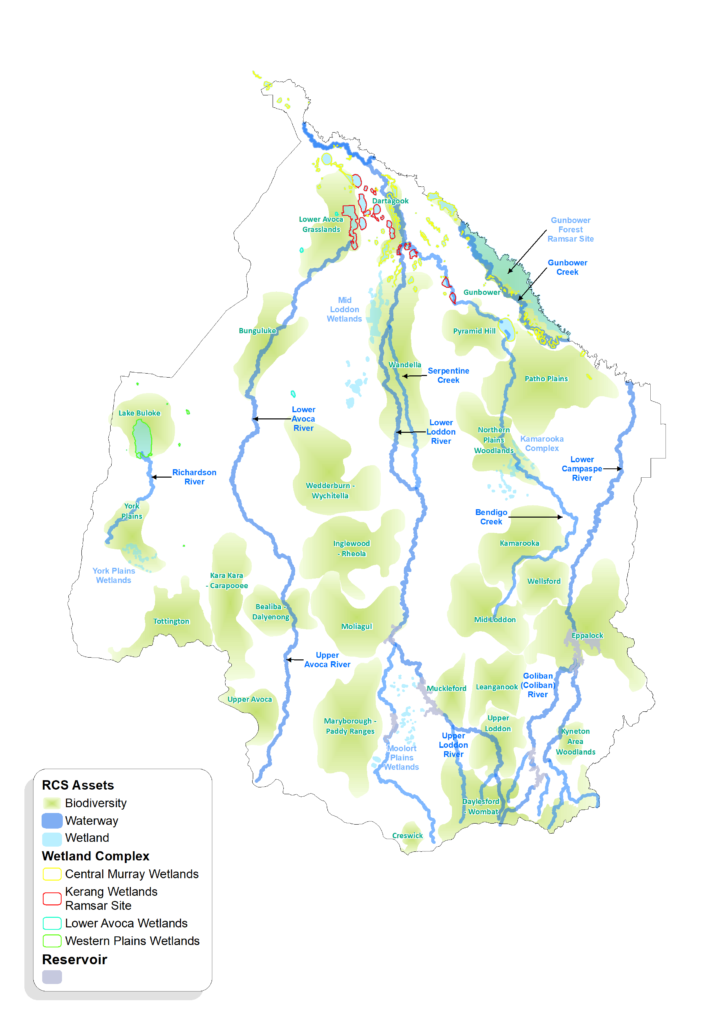The north central region covers 13% (three million hectares) of Victoria. It comprises four inland river catchments – the Campaspe, Loddon, Avoca and Avon-Richardson – that rise on the northern slopes of the Great Dividing Range and flow northward onto the wide, flat riverine plains of northern Victoria. The catchments form part of the Murray-Darling Basin.
The region includes the traditional lands of the Dja Dja Wurrung, Taungurung, Yorta Yorta, Barapa Barapa, Wamba Wemba and Wadi Wadi peoples and the clans represented by Barengi Gadjin Land Council. Continuing to work towards self-determined participation and leadership of Traditional Owners in caring for Country is an important priority identified in this RCS.
The North Central RCS identifies priority assets to focus investment, including waterways, wetlands and biodiversity assets, as shown on the map here. Connections between these assets, places that are valued by local communities and places and landscapes that have cultural value to Traditional Owners, may not be captured by the priority assets, but are nonetheless important.
The region’s waterways, which encompass more than 100,000 km of streams and 1600 wetlands, have significant economic, environmental, cultural and social values. The region is home to two internationally recognised Ramsar wetlands, Gunbower Forest and Kerang Wetlands, which support many migratory waterbirds. Recent research indicates that our region’s waterways have not recovered from the millennium drought and are vulnerable to future drying under climate change. Maximising the potential of available water, will be important.
The natural environment and its biodiversity are fundamental to our economy, our physical and mental wellbeing. The region supports unique flora and fauna species, and many threatened species and communities as well. Our changing climate is putting increased pressure on the region’s natural environment. Significant changes in species distribution are predicted and local extinctions are likely. Protecting what we have, building ecosystem resilience and connectivity, will be priorities for the next six years and beyond. The carbon market presents opportunities to increase the extent of native vegetation, and it will be important that we collaborate to maximise biodiversity benefits of this investment.

The region has a Mediterranean climate with winter dominant rainfall and evaporation highest over the summer months, although rainfall patterns have changed over the past 30 years, and over the long term, winter and spring rainfall is predicted to decrease. With reduced rainfall and increased temperatures our future climate will be hotter and drier overall. The impacts of climate change are pervasive, exacerbating existing threats and vulnerabilities. The region’s landholders are already adapting to our changing climate. Continuing to trial and adopt land use practices that increase resilience, and support the long-term sustainability of agriculture in the region under climate change, will be important.
Eighty-seven per cent of land in the region is privately owned and most of it utilised for agriculture. In the steeper terrain of the uplands, land is mostly used for livestock grazing. Further north, in the gentler more undulating foothills of the Campaspe, Loddon, Avoca and Avon-Richardson river basins, cropping is common alongside mixed farming enterprises. Dryland farming is practiced on more than two million hectares and accounts for approximately 66% of the region’s total land use, with most of the irrigated agriculture located within the Goulburn Murray Irrigation District (GMID) in the north. Improving soil health continues to be an important priority for farmers across the region. Reduced water availability in the region, has already caused significant changes to irrigated agriculture within the GMID. Continuing to improve the efficiency of irrigation systems, support increased resilience and long-term productivity of irrigated agriculture in this area will be important.
A prosperous regional economy has a very real impact on our collective ability to protect and enhance our natural resources. Agriculture is the dominant land use and mainstay of the regions economy. Changes and trends in the agricultural sector are discussed in this RCS. Employment in high skill service industries is concentrated in the southeast around Bendigo or within commuting distance to Melbourne, where the population is growing. Tourism is important for the regional economy, and the health of our natural resources directly supports agritourism and nature-based tourism in particular. Mining exploration activity has recently increased in some parts of the region. Several solar farms are operating and more are proposed across the northern parts of the region. Upgrades to the transmission network are also proposed across the region, to support renewable energy development more broadly.
Over 250,000 people call the north central region home. Almost half the population live in the City of Greater Bendigo, which is one of the fastest growing Local Government Areas in regional Victoria. Macedon Ranges, Mitchell, Mount Alexander and Hepburn shires are attracting significant numbers of tree-changers. Population growth and associated development is putting increasing pressure on our natural resources which is a key challenge for those areas. Whilst in the north and west of the region, an ageing population and continuing trend toward larger/corporate farms is contributing to further population decline and associated socio-economic impacts, including a reduced volunteer base.
We are fortunate to have more than 200 community-based environment groups including Landcare groups and networks, sustainable agriculture groups and others, actively working across the region. Supporting community-based groups to continue their good work, and increasing the number of environmental volunteers in the region are priorities of this RCS. Changes to the demographics of the region present both challenges and opportunities for engagement in NRM across the region.
This RCS has been developed together with Traditional Owners, partner organisations and the community. It provides a solid foundation for working together to achieve meaningful NRM outcomes. The health of our catchments relies on the active involvement of people in the region. People who farm and manage land or who live in towns, work, volunteer or go to school all have a role to play in achieving the North Central RCS 2021-27 vision.


